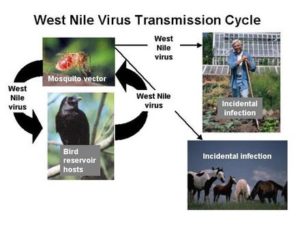From Bio Med Central
December 1, 2017
News of West Nile virus (WNV) first hit the popular press in 1999 when cases of infection in humans were identified in Queen’s, New York, USA. It quickly spread across the whole of the US, carried by infected birds, and 3 million people are estimated to have been infected between 1999 and 2010. Since then more outbreaks have occurred in the US, typically in August and September. However, sporadic outbreaks occurred in Europe before this, and still do. Its geographic range is expanding in Europe, causing increasing numbers of epidemics.

WNV was first discovered in the West Nile district of Uganda. It is a flavivirus that is transmitted by mosquitoes in the genus Culex, that have fed on infected birds. While this is the natural transmission cycle, horses and humans can also be infected. Most humans infected with the virus are symptomless, but it can cause a fever, headache and rash (West Nile Fever). However, in less than 1% of cases the virus infects the nervous system causing severe symptoms, that can result in death. Horses are particularly susceptible to infection, and it can be fatal in up to 40% of cases.
